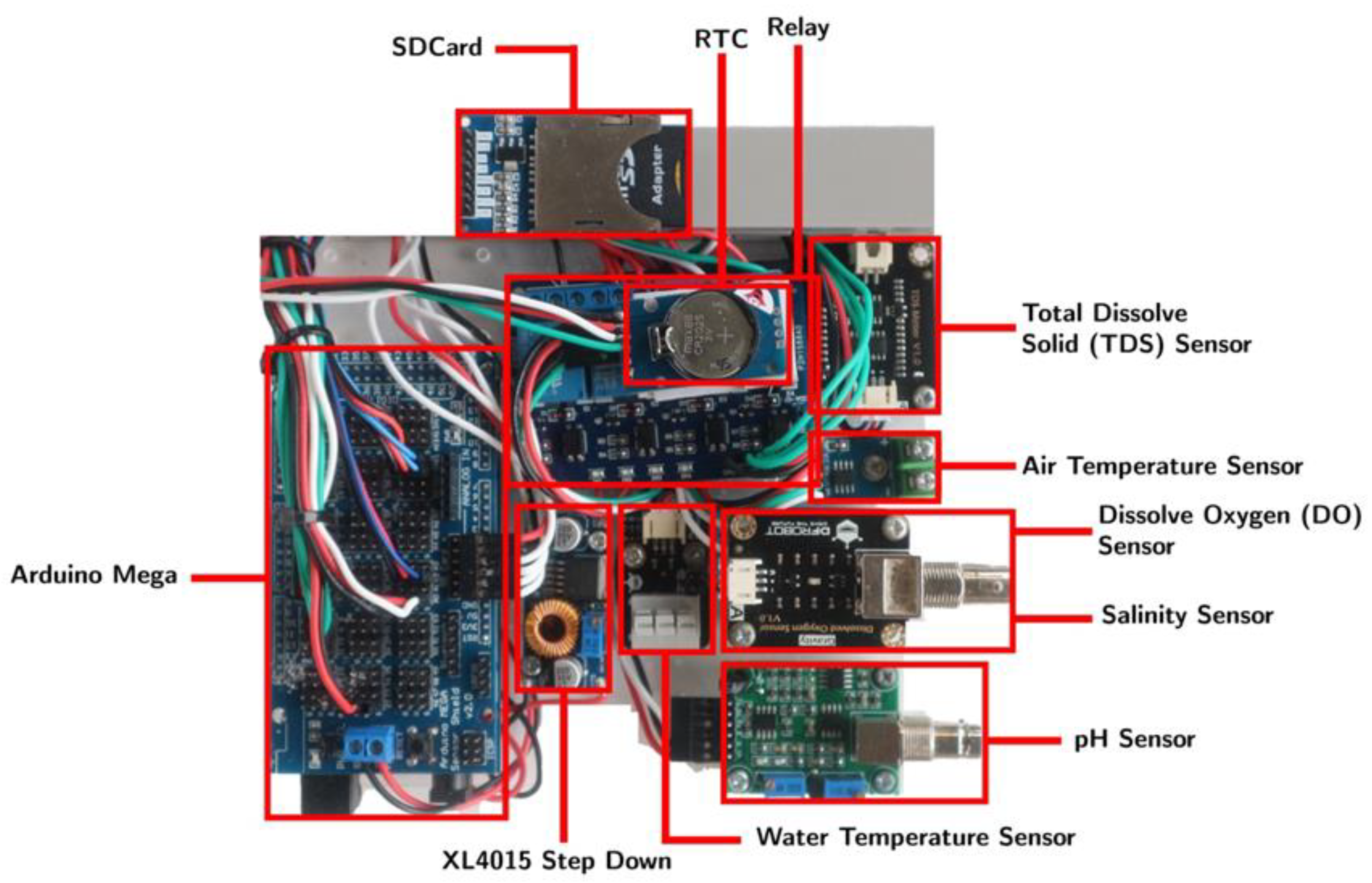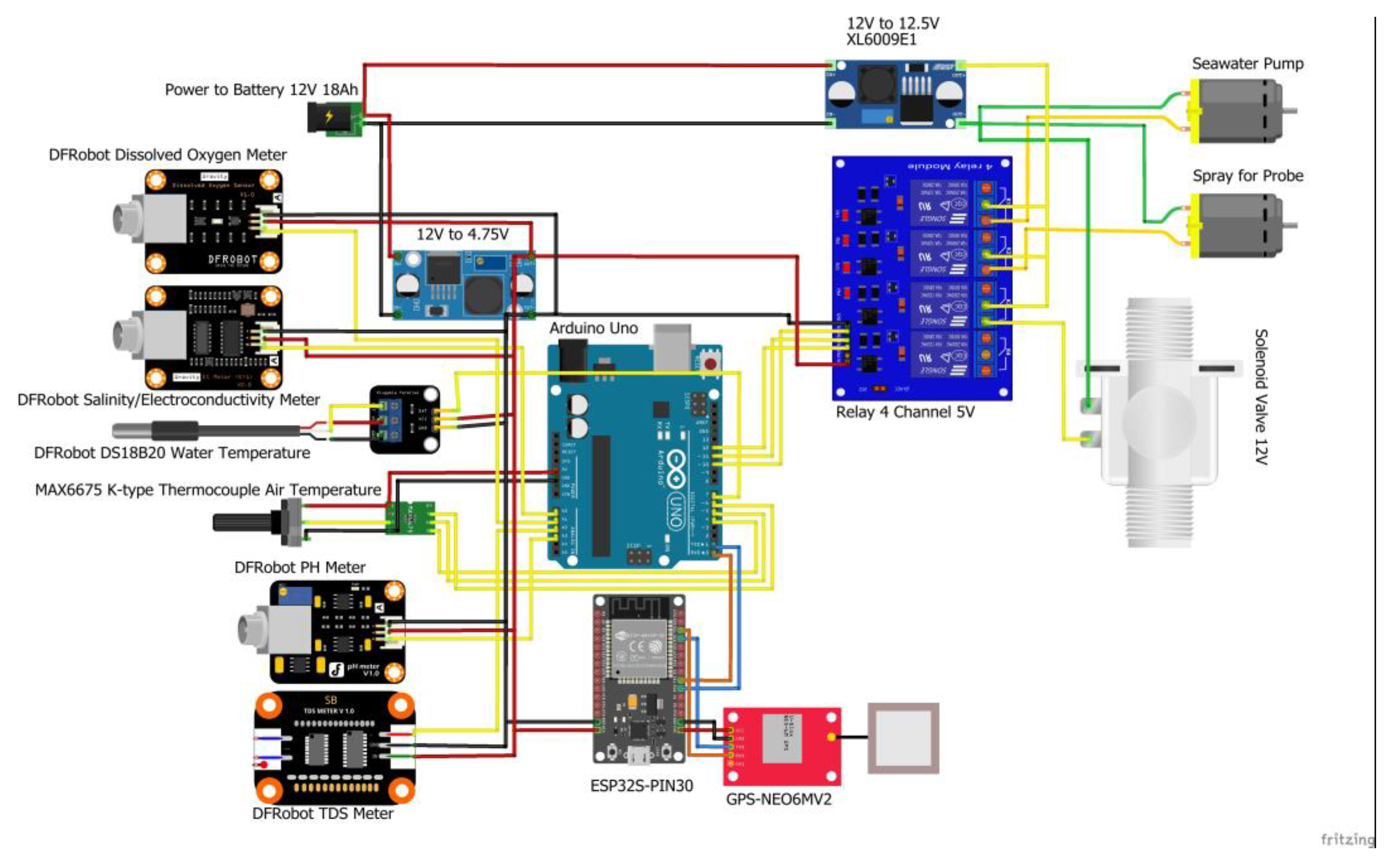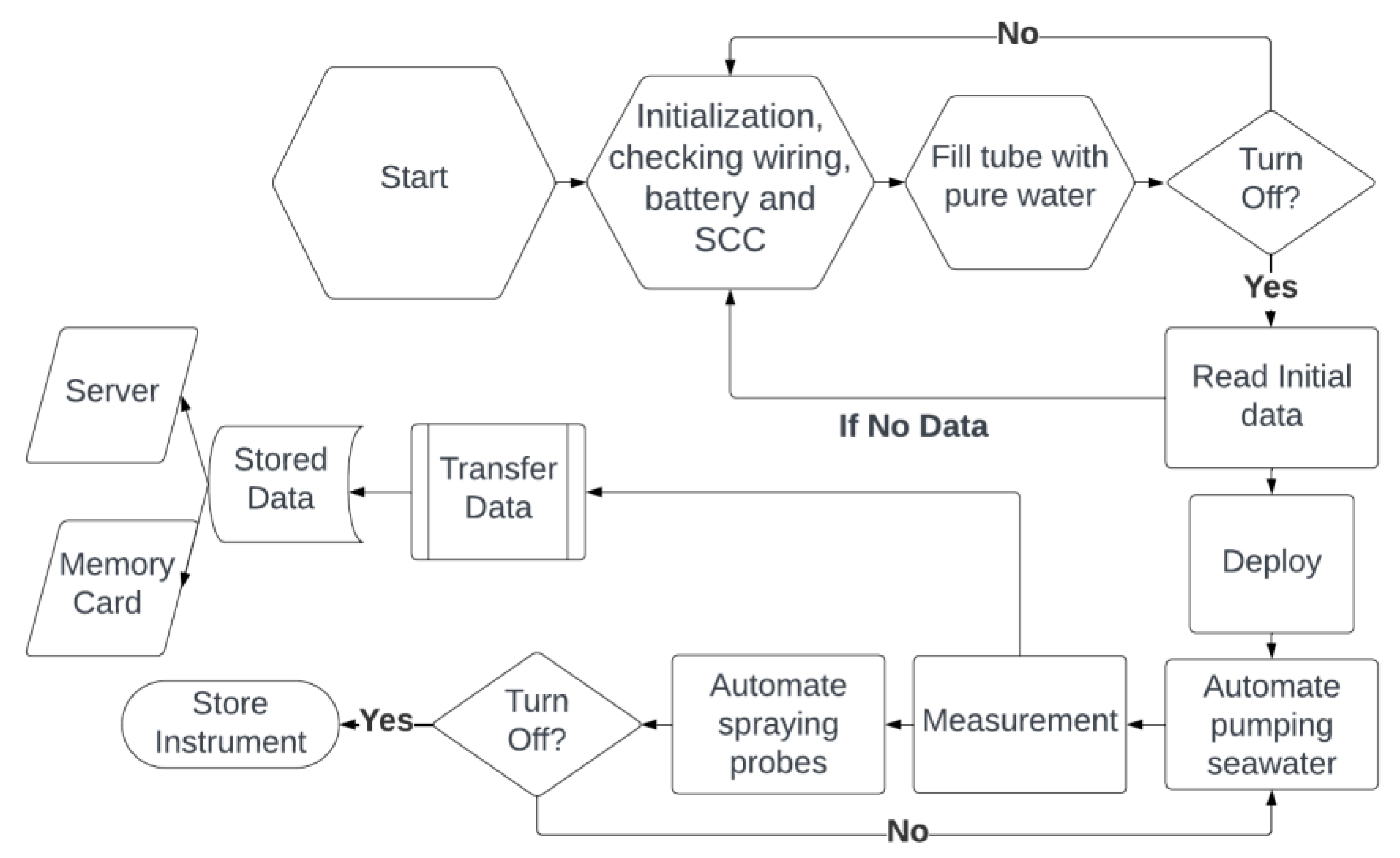NOBEL-BOX: Development of a Low-Cost Ship-Based Instrument for Ocean Monitoring
Abstract
:1. Introduction
2. Materials and Methods
2.1. System Description
2.2. Sensors and Calibrations
| Component | Accuracy/Range | Working Range | Time to Recalibrate | Average Life of Probe | Manufacturer |
|---|---|---|---|---|---|
| Gravity: DS18B20 Temperature Sensor (DS18B20) | ±0.5 °C | −10 °C to +85 °C | N/A | N/A | DFRobot, Shanghai-China |
| Thermocouple Temperature Sensor K-Type (MAX6675) | ±0.25 °C | −20°to +80° | N/A | N/A | Maxim Integrated Product, CA, USA |
| Gravity: Analog Dissolved Oxygen Sensor (SEN0237) | ±0.05 mg/L | 0 to 20 mg/L | ~1 year | >0.5 year | DFRobot, Shanghai-China |
| Sensor TDS Meter V1.0 for Arduino Analog TDS (XH2.54-3P) | ±10% F.S. (25 °C) | 0 to 1000 ppm | N/A | >0.5 year | DFRobot, Shanghai-China |
| Module Analog P.H. Sensor Kit PH-4502C Electrode Probe (PH-4502C) | ±0.1 P.H. | 0 to 14 | ~1 year | >0.5 year | DFRobot, Shanghai-China |
| Gravity: Analog Electrical Conductivity Sensor Meter v2 K = 10 (EP000533) | ±5% F.S. | 0 to 20 ms/cm | N/A | >0.5 year | DFRobot, Shanghai-China |
2.3. Operations Instructions
3. Results
3.1. Final Design
3.2. Testing
3.3. Data Analysis
4. Discussion
5. Conclusions
6. Patents
Author Contributions
Funding
Institutional Review Board Statement
Informed Consent Statement
Data Availability Statement
Acknowledgments
Conflicts of Interest
References
- Guo, Y.; Wang, L.F. Destinations and pathways of the Indonesian Throughflow water in the Indian Ocean. J. Clim. 2023, 36, 3717–3735. [Google Scholar] [CrossRef]
- Katavouta, A.; Polton, J.A.; Harle, J.D.; Holt, J.T. Effect of Tides on the Indonesian Seas Circulation and Their Role on the Volume, Heat and Salt Transports of the Indonesian Throughflow. J. Geophys. Res. Ocean. 2022, 127, e2022JC018524. [Google Scholar] [CrossRef]
- Scroxton, N.; Gagan, M.K.; Ayliffe, L.K.; Hantoro, W.S.; Hellstrom, J.C.; Cheng, H.; Edwards, R.L.; Zhao, J.-X.; Suwargadi, B.W.; Rifai, H. Antiphase response of the Indonesian–Australian monsoon to millennial-scale events of the last glacial period. Sci. Rep. 2022, 12, 20214. [Google Scholar] [CrossRef]
- Xie, T.; Newton, R.; Schlosser, P.; Du, C.; Dai, M. Long-Term Mean Mass, Heat and Nutrient Flux through the Indonesian Seas, Based on the Tritium Inventory in the Pacific and Indian Oceans. J. Geophys. Res. Oceans 2019, 124, 3859–3875. [Google Scholar] [CrossRef]
- Taufiqurrahman, E.; A’an, J.W.; Masumoto, Y. The Indonesian throughflow and its impact on biogeochemistry in the Indonesian Seas. ASEAN J. Sci. Technol. Dev. 2020, 37, 29–35. [Google Scholar] [CrossRef]
- Adyasari, D.; Pratama, M.A.; Teguh, N.A.; Sabdaningsih, A.; Kusumaningtyas, M.A.; Dimova, N. Anthropogenic impact on Indonesian coastal water and ecosystems: Current status and future opportunities. Mar. Pollut. Bull. 2021, 171, 112689. [Google Scholar] [CrossRef] [PubMed]
- Purba, N.P.; Faizal, I.; Cordova, M.R.; Abimanyu, A.; Afandi, N.K.; Indriawan, D.; Khan, A.M. Marine Debris Pathway Across Indonesian Boundary Seas. J. Ecol. Eng. 2021, 22, 82–98. [Google Scholar] [CrossRef]
- Halpern, B.S.; Frazier, M.; Afflerbach, J.; O’hara, C.; Katona, S.; Lowndes, J.S.S.; Jiang, N.; Pacheco, E.; Scarborough, C.; Polsenberg, J. Drivers and implications of change in global ocean health over the past five years. PLoS ONE 2017, 12, e0178267. [Google Scholar] [CrossRef]
- Révelard, A.; Tintoré, J.; Verron, J.; Bahurel, P.; Barth, J.A.; Belbéoch, M.; Benveniste, J.; Bonnefond, P.; Chassignet, E.P.; Cravatte, S.; et al. Ocean Integration: The Needs and Challenges of Effective Coordination within the Ocean Observing System. Front. Mar. Sci. 2022, 8, 737671. [Google Scholar] [CrossRef]
- Xavier, F.N.d.C.; Martins, L.D.; Oyamada, M.S.; Spanhol, F.A.; Coutinho, F.R.; Pfrimer, F.W.D.; de Camargo, E.T. Evaluation of low-cost sensors for real-time water quality monitoring. In Anais Estendidos do XII Simpósio Brasileiro de Engenharia de Sistemas Computacionais; SBC: Kalbadevi, Mumbai, 2022; pp. 56–61. [Google Scholar] [CrossRef]
- Butler, J.; Florida International University; Pagniello, C. Emerging, Low-Cost Ocean Observing Technologies to Democratize Access to the Ocean. Oceanography 2021, 34, 94–95. [Google Scholar] [CrossRef]
- Marcelli, M.; Piermattei, V.; Madonia, A.; Mainardi, U. Design and Application of New Low-Cost Instruments for Marine Environmental Research. Sensors 2014, 14, 23348–23364. [Google Scholar] [CrossRef] [PubMed]
- Roemmich, D.; Johnson, G.; Riser, S.; Davis, R.; Gilson, J.; Owens, W.B.; Garzoli, S.; Schmid, C.; Ignaszewski, M. The Argo Program: Observing the Global Oceans with Profiling Floats. Oceanography 2009, 22, 34–43. [Google Scholar] [CrossRef]
- Liu, Y.; Qiu, M.; Liu, C.; Guo, Z. Big data challenges in ocean observation: A survey. Pers. Ubiquitous Comput. 2016, 21, 55–65. [Google Scholar] [CrossRef]
- Levin, L.A.; Bett, B.J.; Gates, A.R.; Heimbach, P.; Howe, B.M.; Janssen, F.; McCurdy, A.; Ruhl, H.A.; Snelgrove, P.; Stocks, K.I.; et al. Global Observing Needs in the Deep Ocean. Front. Mar. Sci. 2019, 6, 241. [Google Scholar] [CrossRef]
- Gerin, R.; Zennaro, M.; Rainone, M.; Pietrosemoli, E.; Poulain, P.M.; Crise, A. On the design of a sustainable ocean drifter for developing countries. EAI Endorsed Trans. Internet Things 2018, 4, e5. [Google Scholar] [CrossRef]
- Wilson, T.; Barth, J.; Pierce, S.; Kosro, P.; Waldorf, B. A Lagrangian drifter with inexpensive wide area differential GPS positioning. In Proceedings of the OCEANS 96 MTS/IEEE Conference Proceedings, The Coastal Ocean—Prospects for the 21st Century, Fort Lauderdale, FL, USA, 23–26 September 1996. [Google Scholar] [CrossRef]
- de Camargo, E.T.; Spanhol, F.A.; Slongo, J.S.; da Silva, M.V.R.; Pazinato, J.; Lobo, A.V.d.L.; Coutinho, F.R.; Pfrimer, F.W.D.; Lindino, C.A.; Oyamada, M.S.; et al. Low-Cost Water Quality Sensors for IoT: A Systematic Review. Sensors 2023, 23, 4424. [Google Scholar] [CrossRef] [PubMed]
- Demetillo, A.T.; Japitana, M.V.; Taboada, E.B. A system for monitoring water quality in a large aquatic area using wireless sensor network technology. Sustain. Environ. Res. 2019, 29, 12. [Google Scholar] [CrossRef]
- Kuznetsov, A.S.; Shapovalov, Y.I.; Shapovalov, R.O. Results of Monitoring the Surface Fields Dynamics in the Black Sea Waters Using a Ferry Box System. Phys. Oceanogr. 2019, 26, 341–349. [Google Scholar] [CrossRef]
- Petersen, W. Innovative Sensor Carriers for Cost-Effective Global Ocean Samplings-Platforms of opportunity in action: The FerryBox system. In Challenges and Innovations in Ocean In Situ Sensors-Measuring Inner Ocean Processes and Health in the Digital Age; Elsevier: Amsterdam, The Netherlands, 2019. [Google Scholar]
- Irion, R. Ocean Scientists Find Life, Warmth in the Seas. Science 1998, 279, 1302–1303. [Google Scholar] [CrossRef]
- Langis, D.P. Arduino Based Oceanographic Instruments: An Implementation Strategy for Low-Cost Sensors; California State Maritime Academy: Vallejo, CA, USA, 2015. [Google Scholar]
- Gunia, M.; Laine, M.; Malve, O.; Kallio, K.; Kervinen, M.; Anttila, S.; Kotamäki, N.; Siivola, E.; Kettunen, J.; Kauranne, T. Data fusion system for monitoring water quality: Application to chlorophyll-a in Baltic sea coast. Environ. Model. Softw. 2022, 155, 105465. [Google Scholar] [CrossRef]
- Macovei, V.A.; Petersen, W.; Brix, H.; Voynova, Y.G. Reduced Ocean Carbon Sink in the South and Central North Sea (2014–2018) Revealed from FerryBox Observations. Geophys. Res. Lett. 2021, 48, e2021GL092645. [Google Scholar] [CrossRef]
- Zenyda, K.S.; Subiyanto; Faizal, I.; Prayogo, N.; Purba, N.P. Evaluation of a New Integrated Marine Instruments: RHEA (Drifter GPS Oceanography Coverage Area). IOP Conf. Ser. Earth Environ. Sci. 2021, 925, 012057. [Google Scholar] [CrossRef]
- Purba, N.P.; Faizal, I.; Mulyani, P.G.; Prayogo, N.; Prasetyo, T.; Khan, A.M. Performance of lagriangan drifter oceanography coverage area (RHEA): Second phase. Int. J. Ocean. Oceanogr. 2019, 13, 353–361. [Google Scholar]
- Purba, N.P.; Faizal, I.; Valino, D.A.; Kang, H.S.; Sugianto, E.; Martasuganda, M.K.; Abimanyu, A.; Bratasena, T.; Zenyda, K.S.; Prayogo, N.; et al. Development of autonomous multi-sensor ocean monitoring instrument designed for complex archipelagic waters. Int. J. Environ. Sci. Technol. 2023, 20, 11451–11460. [Google Scholar] [CrossRef]
- Hakimi, I.M.; Jamil, Z. Development of Water Quality Monitoring Device Using Arduino UNO. IOP Conf. Ser. Mater. Sci. Eng. 2021, 1144, 012064. [Google Scholar] [CrossRef]
- Rao, A.S.; Marshall, S.; Gubbi, J.; Palaniswami, M.; Sinnott, R.; Pettigrovet, V. Design of low-cost autonomous water quality monitoring system. In Proceedings of the 2013 International Conference on Advances in Computing, Communications and Informatics (ICACCI), Mysore, India, 22–25 August 2013; pp. 14–19. [Google Scholar] [CrossRef]
- Appiani, A. Arduino® MEGA 2560 Rev3 Features. Arduino® MEGA 2560. Lex Russ. 2022, 4, 1–18. [Google Scholar]
- XLSEMI. Datasheet Buck DC to DC XL4013; 2015, pp. 1–10. Available online: www.xlsmi.com (accessed on 2 August 2023).
- Technology, H. User Guide—4 Channel 5V Optical Isolated Relay Module. Occup. Health Saf. 2015, 74, 24. [Google Scholar]
- Maxim Integrated. DS3231 RTC General Description; 2015; p. 20. Available online: www.maximintegrated.com (accessed on 2 August 2023).
- EBay. Micro SD Card Card Adapter Reader Module for Arduino; 2013; pp. 1–2. Available online: https://www.ebay.com/itm/225559844980 (accessed on 3 August 2023).
- Hitachi. HD44780U (LCD-II); 2015; Volume 3304, pp. 1–19. Available online: https://html.alldatasheet.com/html-pdf/63663/HITACHI/HD44780U/247/1/HD44780U.html (accessed on 10 August 2023).
- Adriman, R.; Fitria, M.; Afdhal, A.; Fernanda, A.Y. An IoT-Based System for Water Quality Monitoring and Notification System of Aquaculture Prawn Pond. In Proceedings of the 2022 IEEE International Conference on Communication, Networks and Satellite (COMNETSAT), Solo, Indonesia, 3–5 November 2022; pp. 356–360. [Google Scholar] [CrossRef]
- Judge, R.; Choi, F.; Helmuth, B. Recent Advances in Data Logging for Intertidal Ecology. Front. Ecol. Evol. 2018, 6, 213. [Google Scholar] [CrossRef]
- Siriwardana, C.; Cooray, A.T.; Liyanage, S.S.; Koliyabandara, S.M.P.A. Seasonal and Spatial Variation of Dissolved Oxygen and Nutrients in Padaviya Reservoir, Sri Lanka. J. Chem. 2019, 2019, 5405016. [Google Scholar] [CrossRef]
- Vinson, N.S.; Ante, S.C.; Roxas, R.J.F.S.; Salvio, S.M.C.; Rabe, S.L.C.; Torres, M.A.J.; Requieron, E.A. Correlation between water quality and seagrass distribution along intertidal zone in Sarangani Province, Philippines. J. Biodiv. Environ. Sci. 2016, 30, 30–35. [Google Scholar]
- Conaco, C.; Cabaitan, P.C. Influence of salinity and temperature on the survival and settlement of Heliopora coerulea larvae. Mar. Pollut. Bull. 2020, 150, 110703. [Google Scholar] [CrossRef] [PubMed]
- Faizal, I.; Purba, N.P. AWS Dataset Pangandaraan; Mendeley Data, V4; 2023. Available online: https://data.mendeley.com/datasets/w3ptrd25yt/4 (accessed on 30 August 2023).
- Firing, E.; Hummon, J.; Chereskin, T. Improving the Quality and Accessibility of Current Profile Measurements in the Southern Ocean. Oceanography 2012, 25, 164–165. [Google Scholar] [CrossRef]
- Auraen, J. Low-Cost CTD Instrument Arduino Based CTD for Autonomous Measurement Platform. Thesis Report, Oslo, Norway 2019. p. 75. Available online: https://www.duo.uio.no/bitstream/handle/10852/68775/1/Low-cost-CTD-Instrument---Arduino-based-CTD-for-autonomous-measurement-platform.pdf (accessed on 30 August 2023).
- Lockridge, G.; Dzwonkowski, B.; Nelson, R.; Powers, S. Development of a Low-Cost Arduino-Based Sonde for Coastal Applications. Sensors 2016, 16, 528. [Google Scholar] [CrossRef]
- Medina, J.D.; Arias, A.; Triana, J.M.; Giraldo, L.F.; Segura-Quijano, F.; Gonzalez-Mancera, A.; Zambrano, A.F.; Quimbayo, J.; Castillo, E. Open-source low-cost design of a buoy for remote water quality monitoring in fish farming. PLoS ONE 2022, 17, e0270202. [Google Scholar] [CrossRef] [PubMed]
- König, C.; Helmi, A.M. Sensitivity Analysis of Sensors in a Hydraulic Condition Monitoring System Using CNN Models. Sensors 2020, 20, 3307. [Google Scholar] [CrossRef]






| pH (Unit) | Water Temp. (°C) | Air Temp. (°C) | Salinity (psu) | TDS (ppm) | DO (mg/L) | |||||||
|---|---|---|---|---|---|---|---|---|---|---|---|---|
| N.B. | PO | NB | PO | NB | PO | NB | PO | NB | PO | NB | PO | |
| Average | 8.219 | 8.197 | 24.013 | 24.156 | 25.036 | 25.028 | 25.698 | 25.495 | 7700.255 | 7739.192 | 4.126 | 3.805 |
| Min. | 7.590 | 7.700 | 23.510 | 23.700 | 24.350 | 24.400 | 17.500 | 18.000 | 7027.400 | 7187.000 | 3.000 | 2.750 |
| Max. | 8.950 | 8.750 | 24.760 | 24.500 | 25.600 | 25.500 | 33.240 | 33.000 | 8658.760 | 8565.000 | 4.830 | 4.380 |
Disclaimer/Publisher’s Note: The statements, opinions and data contained in all publications are solely those of the individual author(s) and contributor(s) and not of MDPI and/or the editor(s). MDPI and/or the editor(s) disclaim responsibility for any injury to people or property resulting from any ideas, methods, instructions or products referred to in the content. |
© 2023 by the authors. Licensee MDPI, Basel, Switzerland. This article is an open access article distributed under the terms and conditions of the Creative Commons Attribution (CC BY) license (https://creativecommons.org/licenses/by/4.0/).
Share and Cite
Purba, N.P.; Faizal, I.; Martasuganda, M.K.; Wulandari, A.; Kusuma, R.S.D.; Ilmi, M.H.; Febriani, C.; Alfarez, R.R.; Argeta, F.; Wicaksana, J.S. NOBEL-BOX: Development of a Low-Cost Ship-Based Instrument for Ocean Monitoring. Sensors 2023, 23, 9654. https://doi.org/10.3390/s23249654
Purba NP, Faizal I, Martasuganda MK, Wulandari A, Kusuma RSD, Ilmi MH, Febriani C, Alfarez RR, Argeta F, Wicaksana JS. NOBEL-BOX: Development of a Low-Cost Ship-Based Instrument for Ocean Monitoring. Sensors. 2023; 23(24):9654. https://doi.org/10.3390/s23249654
Chicago/Turabian StylePurba, Noir P., Ibnu Faizal, Marine K. Martasuganda, Ajeng Wulandari, Rd. Salsa D. Kusuma, Muhammad H. Ilmi, Choerunnissa Febriani, Raffy R. Alfarez, Fickry Argeta, and Jati S. Wicaksana. 2023. "NOBEL-BOX: Development of a Low-Cost Ship-Based Instrument for Ocean Monitoring" Sensors 23, no. 24: 9654. https://doi.org/10.3390/s23249654
APA StylePurba, N. P., Faizal, I., Martasuganda, M. K., Wulandari, A., Kusuma, R. S. D., Ilmi, M. H., Febriani, C., Alfarez, R. R., Argeta, F., & Wicaksana, J. S. (2023). NOBEL-BOX: Development of a Low-Cost Ship-Based Instrument for Ocean Monitoring. Sensors, 23(24), 9654. https://doi.org/10.3390/s23249654







